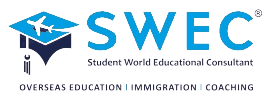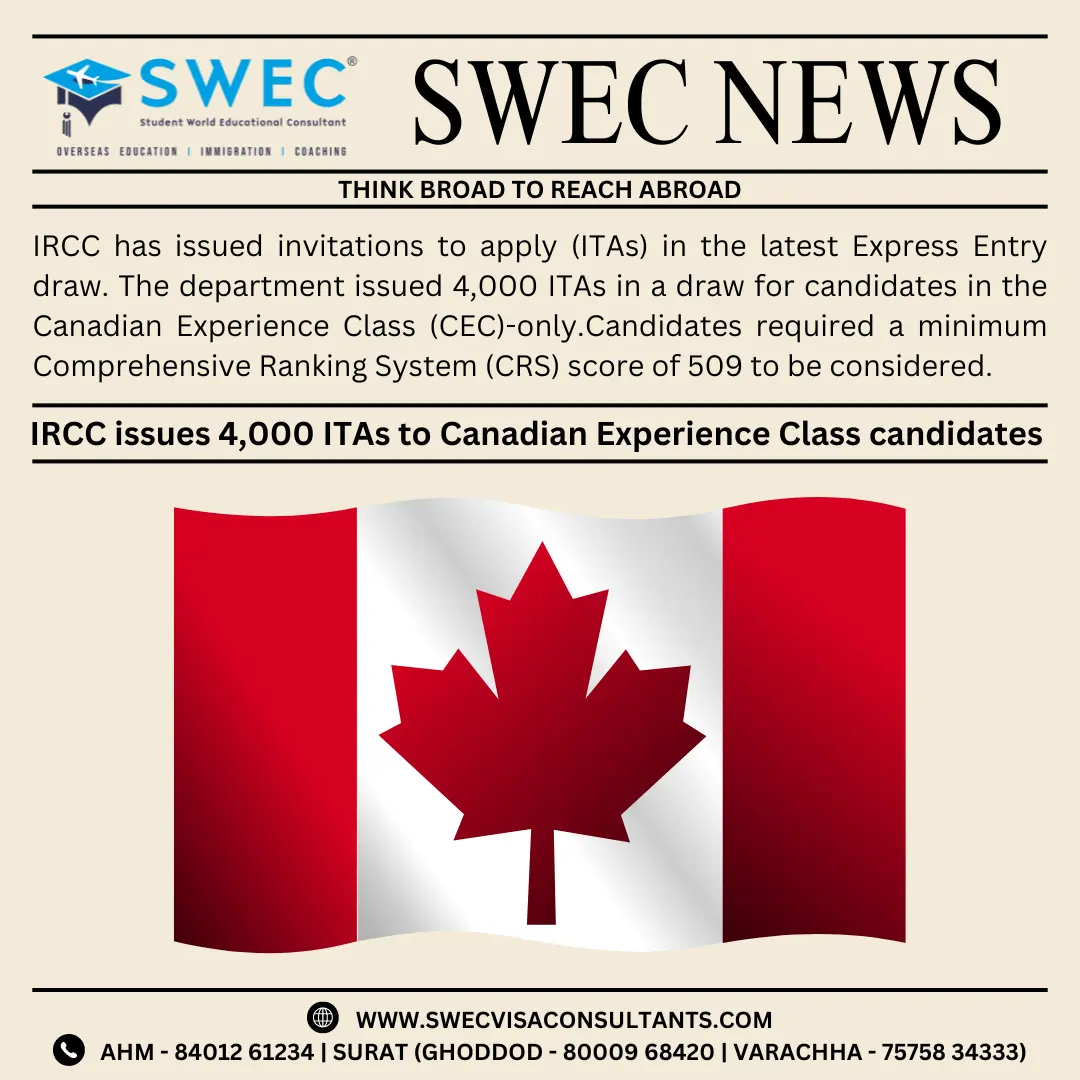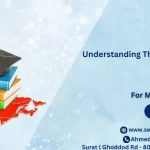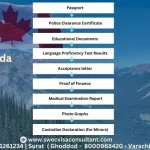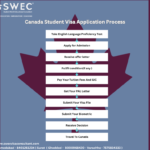The Immigration, Refugees, and Citizenship Canada (IRCC) recently issued 4,000 Invitations to Apply (ITAs) in the latest Canadian Experience Class (CEC)-only Express Entry draw. This draw, held on September 19, 2024, required candidates to have a minimum Comprehensive Ranking System (CRS) score of 509 to qualify.
This was the third Express Entry draw of the month, highlighting IRCC’s ongoing commitment to bringing skilled workers to Canada. Notably, this draw follows two other significant draws from earlier in September:
- On September 13, 1,000 candidates were invited in a category-based selection draw, focusing on French-language proficiency with a CRS score requirement of 446.
- On September 9, 911 candidates were invited under the Provincial Nominee Program (PNP), with a much higher CRS requirement of 732.
The current CEC draw reflects a slight increase in the CRS score compared to the previous CEC-specific draw held on August 27, where the minimum CRS score was 507. However, this draw did not surpass the largest CEC draw of the year, which took place on July 31, 2024, when 5,000 ITAs were issued with a CRS cut-off of 510.
Express Entry Draw Results in 2024:
| Date | Draw Type | Number of ITAs | Minimum CRS Score | Details |
| September 19 | Canadian Experience Class (CEC) | 4,000 | 509 | The third draw in September focusing on CEC candidates, with a slightly higher CRS requirement than the last CEC draw. |
| September 13 | French Language Proficiency | 1,000 | 446 | This draw targeted candidates with strong French language skills, supporting the need for French-speaking immigrants outside Quebec. |
| September 9 | Provincial Nominee Program (PNP) | 911 | 732 | A PNP-specific draw, helping provinces meet regional labor market demands with a high CRS cut-off. |
| August 27 | Canadian Experience Class (CEC) | 3,300 | 507 | A CEC-focused draw aimed at candidates with Canadian work experience. |
| August 26 | Provincial Nominee Program (PNP) | 1,121 | 694 | Another PNP draw, continuing to support provincial employment needs. |
| August 15 | French Language Proficiency | 2,000 | 394 | A large draw targeting French-speaking candidates with a low CRS score requirement. |
| August 14 | Canadian Experience Class (CEC) | 3,200 | 509 | A draw for skilled workers already in Canada under the CEC program. |
| August 13 | Provincial Nominee Program (PNP) | 763 | 690 | Another PNP draw, inviting candidates with provincial nominations and high CRS scores. |
| July 31 | Canadian Experience Class (CEC) | 5,000 | 510 | The largest CEC-specific draw of the year, issuing 5,000 ITAs. |
| July 30 | Provincial Nominee Program (PNP) | 964 | 686 | A continuation of PNP-specific draws to support provincial workforce requirements. |
| July 18 | French Language Proficiency | 1,800 | 400 | A category-based draw for French-speaking candidates to support settlement outside Quebec. |
| July 17 | Canadian Experience Class (CEC) | 6,300 | 515 | The largest CEC draw of the year with 6,300 ITAs, featuring a high CRS requirement of 515. |
| July 16 | Provincial Nominee Program (PNP) | 1,391 | 670 | A significant PNP draw with a substantial number of ITAs for provincially nominated candidates. |
| July 8 | French Language Proficiency | 3,200 | 420 | A large draw to meet the demand for French-speaking immigrants, with a low CRS requirement. |
| July 5 | Healthcare Occupations | 3,750 | 445 | A draw specifically targeting healthcare professionals to address workforce shortages in the sector. |
| July 4 | Trade Occupations | 1,800 | 436 | A targeted draw for candidates with experience in skilled trades. |
| July 2 | Provincial Nominee Program (PNP) | 920 | 739 | A PNP draw with a high CRS requirement, addressing provincial labor needs. |
| June 19 | Provincial Nominee Program (PNP) | 1,499 | 663 | Another PNP draw aimed at filling critical regional employment gaps. |
| May 31 | Canadian Experience Class (CEC) | 3,000 | 522 | A CEC draw targeting skilled workers with Canadian work experience. |
| May 30 | Provincial Nominee Program (PNP) | 2,985 | 676 | A large PNP draw supporting provincial workforce demands. |
| April 24 | French Proficiency | 1,400 | 410 | A draw for French-speaking candidates to support Canada’s linguistic diversity. |
| April 23 | General | 2,095 | 529 | A general draw inviting a wide range of candidates across multiple sectors. |
| April 11 | STEM Occupations | 4,500 | 491 | A major draw targeting candidates in Science, Technology, Engineering, and Mathematics (STEM) fields. |
| April 10 | General | 1,280 | 549 | A general draw focused on candidates with high CRS scores. |
| March 26 | French Language Proficiency | 1,500 | 388 | A draw aimed at increasing French-speaking immigrants outside Quebec, with a low CRS cut-off. |
| March 25 | General | 1,980 | 524 | A general draw for a wide range of skilled workers. |
| March 13 | Transport Occupations | 975 | 430 | A draw focusing on candidates in the transport sector, addressing the need for truck drivers and other transport workers. |
| March 12 | General | 2,850 | 525 | A general draw inviting a significant number of skilled workers across various industries. |
| February 29 | French Language Proficiency | 2,500 | 336 | A large draw aimed at Francophone candidates, with one of the lowest CRS cut-offs of the year. |
| February 28 | General | 1,470 | 534 | A general draw targeting a broad spectrum of skilled workers. |
| February 16 | Agriculture and Agri-Food Occupations | 150 | 437 | A small but crucial draw targeting candidates in the agriculture and agri-food industries. |
| February 14 | Healthcare Occupations | 3,500 | 422 | A healthcare-focused draw to meet the demand for healthcare professionals in Canada. |
| February 13 | General | 1,490 | 535 | A general draw for candidates across various industries with high CRS scores. |
| February 1 | French Language Proficiency | 7,000 | 365 | The largest French language proficiency draw of the year, inviting 7,000 candidates. |
| January 31 | General | 730 | 541 | A general draw with a relatively high CRS score requirement. |
| January 23 | General | 1,040 | 543 | A draw focusing on skilled workers across multiple sectors. |
| January 10 | General | 1,510 | 546 | One of the earliest draws of 2024, focusing on high-scoring candidates in various professions. |
Key Takeaways
- Canadian Experience Class (CEC) draws continue to be a significant portion of ITA issuance, especially in the latter half of the year.
- French language proficiency is a recurring category-based selection draw, highlighting the importance of bilingualism in Canada’s immigration strategy.
- The Provincial Nominee Program (PNP) draws remain essential for addressing specific labor needs in various provinces, with high CRS scores required for nomination.
- Specialized draws for healthcare, STEM, trades, agriculture, and transport occupations reflect the Canadian government’s focus on filling critical workforce shortages in specific industries.
Understanding the Express Entry System
The Express Entry system, launched in 2015, manages applications for Canada’s three main economic immigration programs:
- Federal Skilled Worker Program (FSWP)
- Federal Skilled Trades Program (FSTP)
- Canadian Experience Class (CEC)
These programs aim to invite the most skilled individuals to apply for permanent residency in Canada. Express Entry operates using the Comprehensive Ranking System (CRS), which assigns scores to candidates based on key human capital factors, including:
- Language ability (English and/or French)
- Education
- Work experience
- Age
- Occupation
Candidates with the highest CRS scores are issued ITAs during Express Entry draws, making them eligible to apply for permanent residency.
Recent Trends: Category-Based Selection and Specialized Draws
In 2023, IRCC introduced category-based selection for Express Entry, focusing on candidates with specific skills and attributes that align with Canada’s labor market needs. This strategic approach was developed to fill critical workforce gaps and support demographic goals.
IRCC currently selects candidates based on the following six categories:
- Healthcare occupations
- Science, technology, engineering, and mathematics (STEM) professions
- Skilled trades
- Transport occupations
- Agriculture and agri-food
- French language proficiency
These categories were chosen based on input from various stakeholders and reflect Canada’s aim to strengthen its economy, address skill shortages, and support demographic growth. For example, the French language proficiency category encourages immigration to French-speaking communities outside Quebec, promoting linguistic diversity and supporting minority French-speaking communities across Canada.
Canadian Experience Class: A Pathway to Permanent Residency
The Canadian Experience Class (CEC) is one of the most popular pathways to permanent residency for individuals already living and working in Canada. Candidates eligible for CEC are typically skilled workers with Canadian work experience, making them highly competitive in the Express Entry pool due to their familiarity with Canada’s job market, language, and culture.
CEC candidates often have lower CRS scores compared to those in the Federal Skilled Worker Program (FSWP) or Federal Skilled Trades Program (FSTP), but still meet the criteria for permanent residency. These draws emphasize the importance of local work experience in obtaining a permanent resident visa.
Provincial Nominee Program: A Key Component of Canada’s Immigration Strategy
The Provincial Nominee Program (PNP) continues to play a critical role in Canada’s immigration strategy, allowing provinces and territories to nominate candidates who meet specific local labor market needs. PNP draws often have higher CRS score requirements due to the additional 600 points awarded to candidates who receive provincial nominations.
Candidates selected through the PNP can settle in specific provinces and contribute to the regional workforce. With PNP draws becoming more frequent, it’s evident that provinces are increasingly relying on this program to address unique labor shortages.
Processing Time and Final Application Steps
Once a candidate receives an Invitation to Apply (ITA), they have 60 days to submit their full application for permanent residency. IRCC aims to process these applications within a six-month service standard.
Candidates should ensure their application is complete and accurate to avoid delays. Any missing information or documents can result in prolonged processing times, and in some cases, applications may be returned or rejected.
Why Choose SWEC for Your Express Entry Journey?
Navigating the Express Entry system can be complex, and that’s where SWEC Visa comes in. With our extensive experience and professional expertise, SWEC Visa helps you understand the nuances of Canada’s immigration system, ensuring your application is prepared with precision and care.
At SWEC, we provide personalized services, including:
- Free Express Entry assessments to determine your eligibility.
- CRS score improvement strategies to maximize your chances of receiving an ITA.
- Comprehensive guidance throughout the application process, from document preparation to submission.
Whether you are aiming to qualify under the Canadian Experience Class (CEC), Provincial Nominee Program (PNP), or any other category, SWEC is here to help you every step of the way.
Start your Express Entry journey today with SWEC Visa and consult our professional visa and immigration experts for a free assessment!
FAQs on Express Entry Draws
Q1. What is the Express Entry system?
Ans1. The Express Entry system is Canada’s application management system for three major economic immigration programs: the Federal Skilled Worker Program (FSWP), the Federal Skilled Trades Program (FSTP), and the Canadian Experience Class (CEC). It uses the Comprehensive Ranking System (CRS) to rank candidates based on factors like language skills, education, work experience, and age. Those with the highest CRS scores receive Invitations to Apply (ITAs) for permanent residency.
Q2. What is a Comprehensive Ranking System (CRS) score?
Ans2. The CRS score is a points-based system used in the Express Entry system to rank candidates based on human capital factors such as language ability, education, work experience, and age. It also accounts for factors like having a sibling in Canada, a job offer, or a high language proficiency score in English or French.
Q3. What is the Canadian Experience Class (CEC)?
Ans3. The Canadian Experience Class (CEC) is an immigration program within the Express Entry system for individuals with Canadian work experience. It allows skilled workers who have been working in Canada to apply for permanent residency based on their local work experience.
Q4. What are Provincial Nominee Program (PNP) draws?
Ans4. PNP draws are part of Canada’s immigration system, where provinces and territories nominate individuals for permanent residency based on local labor market needs. PNP candidates typically have higher CRS scores due to the additional 600 points awarded to those nominated by a province.
Q5. What are category-based Express Entry draws?
Ans5. Category-based Express Entry draws target candidates with specific skills or attributes. In 2023, IRCC introduced this to select candidates based on their occupation or language proficiency in areas such as healthcare, STEM professions, trades, transport, agriculture, and French language proficiency.
Q6. How many ITAs were issued in the latest CEC draw?
Ans6. In the latest Canadian Experience Class (CEC) draw held on September 19, 2024, IRCC issued 4,000 ITAs, with a minimum CRS score of 509.
Q7. How does SWEC Visa assist with Express Entry applications?
Ans7. SWEC Visa offers personalized guidance through the Express Entry process, including free assessments, CRS score improvement strategies, and end-to-end support for application preparation and submission. Their team of professional visa and immigration experts helps you increase your chances of receiving an ITA by optimizing your profile.
Q8. How long does IRCC take to process Express Entry applications?
Ans8. IRCC aims to process finalized Express Entry applications within six months. However, candidates must ensure all documents are accurate and complete to avoid delays in the process.
Q9. What should candidates do after receiving an ITA?
Ans9. After receiving an ITA, candidates have 60 days to submit their full application to IRCC. It is crucial to gather and submit all required documents during this period to avoid complications.
Q10. How can I improve my CRS score?
Ans10. There are several ways to improve your CRS score, including increasing language proficiency, gaining more work experience, pursuing higher education, and securing a valid job offer. Consulting an expert like SWEC Visa can provide tailored strategies for improving your score.
